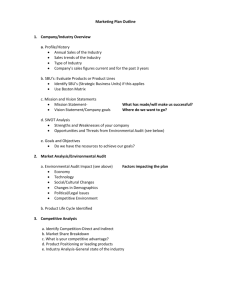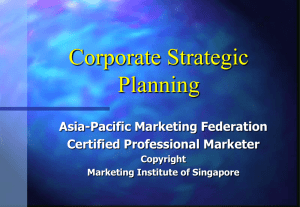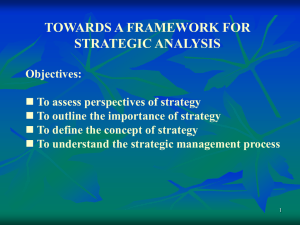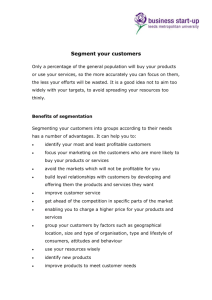1. Many of the elements in the plan are decided upon - Parkway C-2
advertisement
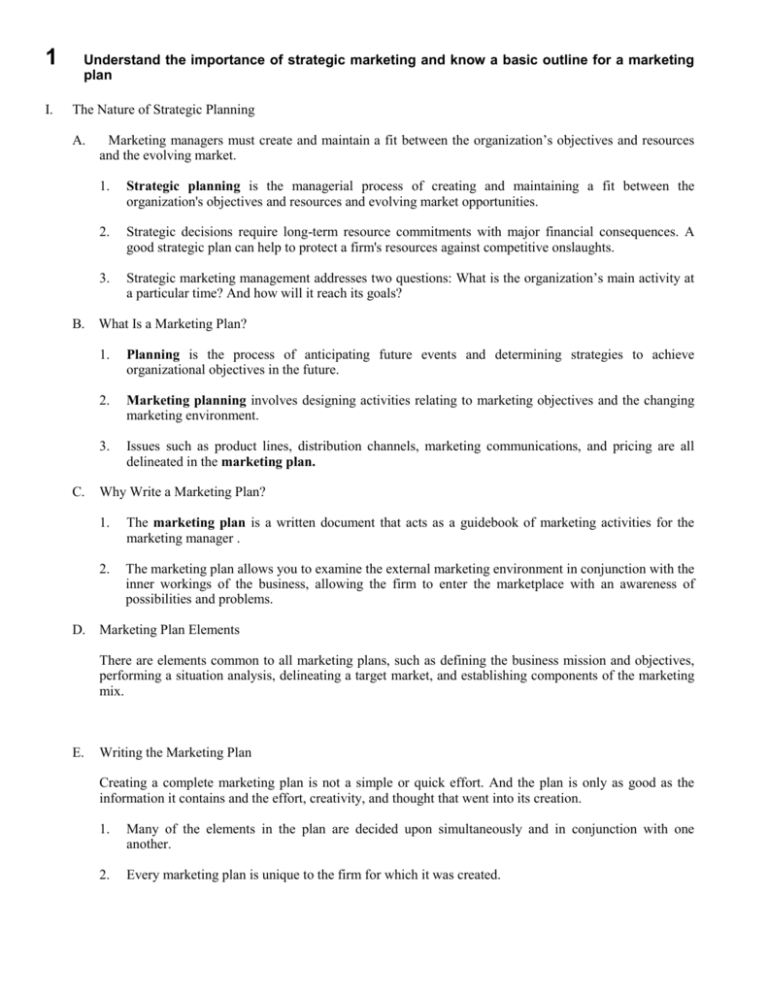
1 I. Understand the importance of strategic marketing and know a basic outline for a marketing plan The Nature of Strategic Planning A. B. C. Marketing managers must create and maintain a fit between the organization’s objectives and resources and the evolving market. 1. Strategic planning is the managerial process of creating and maintaining a fit between the organization's objectives and resources and evolving market opportunities. 2. Strategic decisions require long-term resource commitments with major financial consequences. A good strategic plan can help to protect a firm's resources against competitive onslaughts. 3. Strategic marketing management addresses two questions: What is the organization’s main activity at a particular time? And how will it reach its goals? What Is a Marketing Plan? 1. Planning is the process of anticipating future events and determining strategies to achieve organizational objectives in the future. 2. Marketing planning involves designing activities relating to marketing objectives and the changing marketing environment. 3. Issues such as product lines, distribution channels, marketing communications, and pricing are all delineated in the marketing plan. Why Write a Marketing Plan? 1. The marketing plan is a written document that acts as a guidebook of marketing activities for the marketing manager . 2. The marketing plan allows you to examine the external marketing environment in conjunction with the inner workings of the business, allowing the firm to enter the marketplace with an awareness of possibilities and problems. D. Marketing Plan Elements There are elements common to all marketing plans, such as defining the business mission and objectives, performing a situation analysis, delineating a target market, and establishing components of the marketing mix. E. Writing the Marketing Plan Creating a complete marketing plan is not a simple or quick effort. And the plan is only as good as the information it contains and the effort, creativity, and thought that went into its creation. 1. Many of the elements in the plan are decided upon simultaneously and in conjunction with one another. 2. Every marketing plan is unique to the firm for which it was created. 2 Develop an appropriate business mission statement II. Defining the Business Mission A. The firm's mission statement is the long-term vision based on a careful analysis of benefits sought by present and potential customers and analysis of existing and anticipated environmental conditions. B. Defining the business in terms of goods and services rather than in terms of the benefits customers seek is sometimes called marketing myopia. In this context, the term myopia means narrow, short-term thinking, which can threaten an organization's survival. C. The organization may need to define a mission statement and objectives for a strategic business unit (SBU), which is a subgroup of a single business, or collection of related businesses within the larger organization. Strategic business units will have the following characteristics: 1. 2. 3. 4. 3 A distinct mission and a specific target market Control over their resources Their own competitors Plans independent of the other businesses in the organization Explain the components of a situation analysis III. Conducting a Situation Analysis A. A situation analysis is sometimes referred to as a SWOT analysis. That is, the firm should identify its internal strengths (S) and weaknesses (W) and also examine external opportunities (O) and threats (T). 4 Describe the criteria for stating good marketing objectives IV. Setting Marketing Plan Objectives A. A marketing objective is a statement of what is to be accomplished through marketing activities. B. Marketing objectives should be realistic, measurable, time specific, and compared to a benchmark. When Mountain Dew Sport was introduced the company's goal was to have a 5 percent share of the sports drink market within three years. C. 5 .Objectives communicate marketing management philosophies, provide direction, serve as motivators, are a basis for control, and force executives to clarify their thinking. Identify the sources of competitive advantage V. Competitive Advantage A. Competitive advantage consists of a set of unique features of a company and its products that are perceived by the target market as significant and superior to the competition. B. Factor or factors which cause customers to patronize a firm and not the competition. C. The three types of competitive advantages are cost-competitive advantage, product-service differentiation, and niche competitive advantage. 1. A cost-competitive advantage results from being the low cost competitor in an industry while maintaining satisfactory profits. Sources of cost-competitive advantages include: 2. Product/service differentiation exists when a firm provides something unique that is valuable to buyers. a. Because cost competitive strategies are subject to continual erosion, product/service differentiation tends to provide a longer lasting competitive advantage. b. Brand names offer enduring competitive advantage. 3. A niche competitive advantage seeks to target and effectively serve a single segment of the market. a. b. Small companies with limited resources can compete with larger companies using niche strategies. A market segment that has good growth potential but is not crucial to the success of major competitors is a good candidate for developing a niche strategy. D. Building Sustainable Competitive Advantage 6 1. A sustainable competitive advantage is one that cannot be copied by the competition. 2. The sources of future competitive advantages are the skills and assets of the organization. Skills and assets include patents, copyrights, locations, equipment, technology, customer service, and promotion. 3. A sustainable competitive advantage is a function of the speed with which competitors can imitate a leading company's strategy plans. Identify strategic alternatives and describe tools used to help select alternatives VI. Strategic Directions A. To discover a marketing opportunity or strategic window, management must know how to identify the strategic alternatives. One method is Ansoff’s strategic opportunity matrix. 1. A firm following a market penetration alternative would try to increase market share among existing customers. Cereal manufacturers attempt to increase market share through the intense advertisements of their different offerings. 2. Market development is a strategic alternative that attracts new customers to existing products, perhaps by expanding the target market or expanding geographically. Ideal for finding new uses for old products that will stimulate additional sales among existing customers while also bringing in new buyers. Whirlpool is seeking to be the world leader in the sales of home appliances with its expansion into European and Asian markets. 3. A product development strategy entails the creation of new products for present markets. Advantages of this strategy are current knowledge of the target market and established distribution channels. Colgate’s introduction of Total toothpaste is designed to appeal to the aging Crest generations' changing dental requirements. 4. Diversification refers to a strategy of increasing sales by introducing new products into new markets. This strategy can be very risky when a firm is entering unfamiliar markets. B. Selecting a Strategic Alternative In the Boston Consulting Group’s portfolio matrix, each SBU is classified by its present or forecast growth and market share. 1. 2. 3. 4. A star is a fast-growing market leader. A cash cow usually generates more cash than is needed to maintain market share A problem child (or question mark) shows rapid growth but poor profit margins A dog has low growth potential and a small market share. The next step is to allocate future resources for each SBU: 1. Build if an organization has a current problem child that it believes has the potential to be a star. 2. Hold if an SBU is a very successful cash cow. 3. Harvest too increase the short-term cash return without too much concern for the long-run impact. Appropriate for all SBUs except those classified as stars. 4. Divest problem children and dogs with low shares of low-growth markets. 7 Discuss target market strategies VII. Describing the Marketing Strategy Marketing strategy involves selecting and describing one or more target markets, and developing and maintaining a marketing mix that will produce mutually satisfying exchanges with target markets. A. Target Market Strategy 1. A market segment is a group of individuals or organizations that share one or more characteristics. Market opportunity analysis is the description and estimation of the size and sales potential of market segments that are of interest to the firm. 2. Target market(s) can be selected by appealing to the entire market, concentrating on one segment, or appealing to multiple market segments using multiple marketing mixes. 8 Describe elements of the marketing mix VIII. The Marketing Mix Introduce each of the four P's of marketing. Then point out that a coordinated combination of all four elements is necessary to achieve a successful marketing mix. The term marketing mix refers to a unique blend of product, distribution, promotion, and pricing strategies designed to produce mutually satisfying exchanges with a target market. Distribution is sometimes referred to as place, thus giving us the "four P's" of the marketing mix: product, place, promotion, and price. Example: Target market: People who commute to work Product: Hybrid powered cars Place: Especially larger urban and suburban areas and those having strict pollution standards Promotion: Automotive magazines, TV, Internet Price: Under $20,000 A. Product Strategies The heart of the marketing mix, the starting point, is the product offering and product strategy. The product includes its package, warranty, after-sale service, brand name, company image, and many other factors. B. Distribution Strategies Distribution strategies, which usually involve wholesalers and retailers, are concerned with making products available when and where customers want them. Physical distribution also involves all the business activities that are concerned with storing and transporting raw materials or finished products. C. Promotion Strategies Promotion includes personal selling, advertising, sales promotion, and public relations. Promotion's role in the marketing mix is to inform, educate, persuade, and remind target markets about the benefits of an organization or a product. D. Pricing Strategies Price is what a buyer must give up to obtain a product. Price is often the most flexible of the four marketing mix elements, the quickest element to change. Price is a very important competitive weapon and very important to the organization, because price multiplied by the number of units sold equals total revenue for the firm. 9. Explain why implementation, evaluation, and control of the marketing plan are necessary IX. Following Up The Marketing Plan A. Implementation is the process of gaining the organizational compliance required to put marketing strategies into action. Brilliant marketing strategies are doomed to fail if they are not properly implemented. B. Evaluation entails gauging the extent to which marketing objectives have been achieved during a specified time period. C. Control provides the mechanisms for evaluating marketing results in light of the strategic plan and for correcting actions that do not help the organization reach those goals within budget guidelines. 1. A marketing audit is a thorough, systematic, periodic evaluation of the goals, strategies, structure, and performance of the marketing organization. 2. The marketing audit has four characteristics: Comprehensive - The marketing audit covers all the major marketing issues facing an organization and not just trouble spots. Systematic - The marketing audit takes place in an orderly sequence and covers the organization's marketing environment, internal marketing system, and specific marketing activities. The diagnosis is followed by an action plan with both short-run and long-run proposals for improving overall marketing effectiveness. Independent - The marketing audit is normally conducted by an inside or outside party who is independent enough to have top management's confidence and to be objective. Periodic - The marketing audit should be carried out on a regular schedule instead of only in a crisis. 10. Identify several techniques that help make strategic planning effective X. Effective Strategic Planning Effective strategic planning requires continual attention, creativity, and management commitment. A. It is not an annual but an ongoing process. B. Sound planning is based on creativity. The firm needs to challenge existing assumption. C. Perhaps the most critical element is the support and participation of top management

